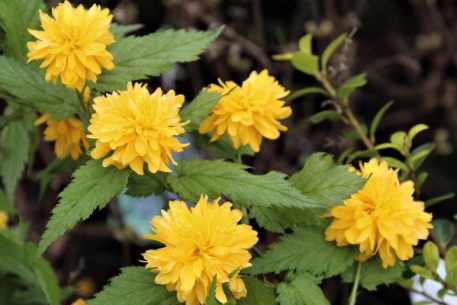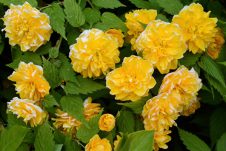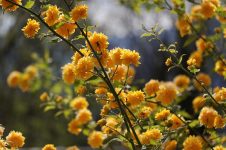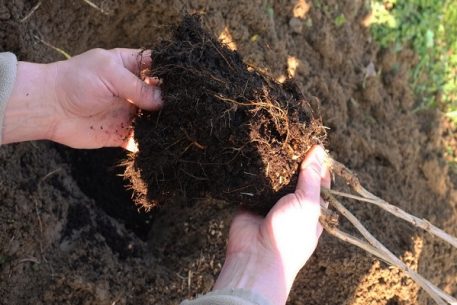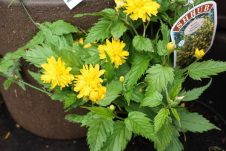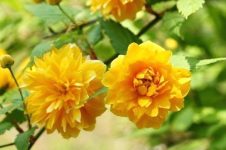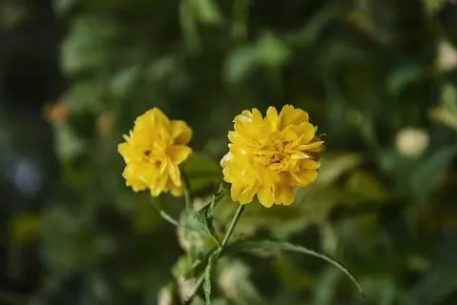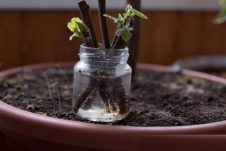Kerria from the Pink family came to temperate latitudes from Japan, China, where it grows in forest and mountainous areas. For the unusual shape of the flowers, the culture received another name - "Easter rose".
Material Content:
Japanese Kerria: a description of the bush
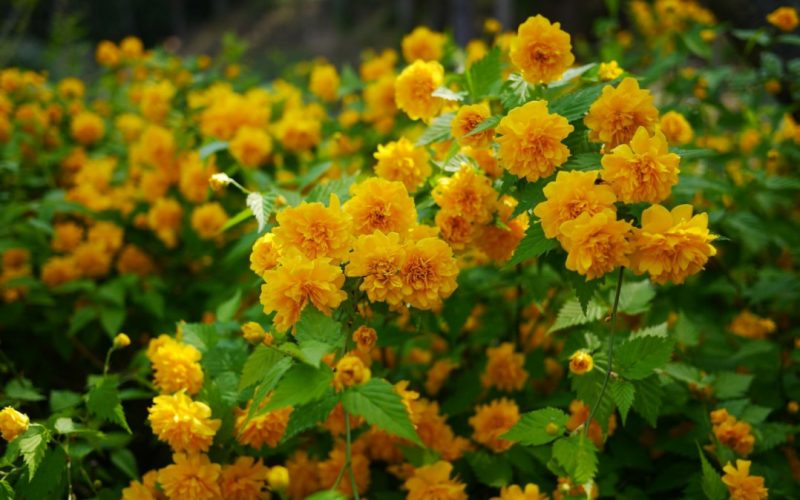
Kerria is represented by deciduous shrubs, characterized by rapid growth. The height of graceful, rod-shaped shoots covered with jagged, lanceolate leaves can reach 3 m. The color of leaf plates resembling raspberry foliage changes from green to deep yellow, observed in autumn. In summer, and sometimes again in the fall season, flowering is observed, in which the crown is covered with single, simple or double flowers of a yellow color.
Popular types and varieties
The genus is represented by one variety, on the basis of which various forms and varieties were bred by breeders:
- Albomarginata is a variegated form that has gained popularity due to asymmetric sheet plates bordered by a white strip. It has a rather slow growth rate.
- Variegata is a fast-growing shrub whose height is 60 cm with a diameter 2 times larger. Gray-green leaf plates of decorative culture are decorated with creamy white spots.
- Argenteo-marginata - a form with a height of up to 3 m blooms with yellow flowers that look expressively against the background of green leaves with a fringing of a white strip.
- Aureovariegata - the form is represented by plants with long flowering, in which double flowers with a complex structure are observed.
- Pleniflora is an abundantly flowering shrub. The yellow flowers resemble small pompons.
Features of growing Japanese Kerry

To grow an exotic shrub, a number of cultural features should be considered:
- love for a lot of scattered light;
- the need for fertile soil that provides health and a long life cycle of kerria;
- resistance to damage by pests and diseases;
- fast recovery after transplantation;
- average frost resistance;
- good survival of planting material during reproduction.
Selecting a place and landing Kerria in the open ground
Before planting kerry seedlings in the garden in early spring or in the first half of autumn, you should determine the place of constant growth. For the representative of exotic flora, slightly shaded areas and sunny areas are suitable. However, in order to ensure the most spectacular and long-lasting flowering in the future, it is recommended to choose areas protected from the wind with an openwork shadow, which is created by tall trees with a not too dense crown.
Landing technology:
- A landing pit is excavated, the dimensions of which are 60x60 cm.
- A fertile substrate is prepared from the arable layer of the extracted land, as well as turf, humus in a ratio of 2: 3: 3 with the addition of a small amount of azofoska.
- At the bottom of the recess, a small mound of substrate is made on which a seedling with spread roots is placed.
- The voids are filled with the remaining soil mixture so that the root neck is flush with the ground.
- The near-stem circle is trampled and watered. Https: //www.youtube.com/watch? V = SZ8ofwou3wU
How to care for shrubs
Kerry shrub needs regular maintenance, which will help maintain a high degree of decorativeness.
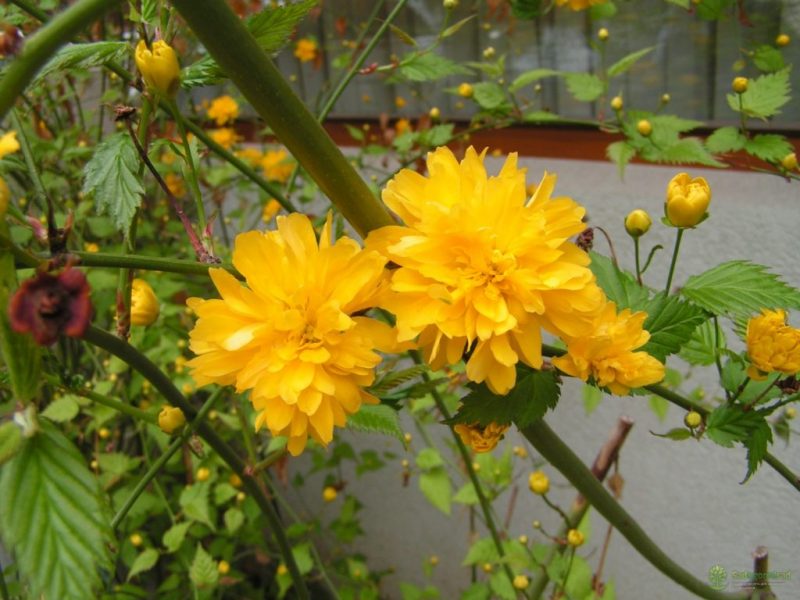
Watering
The need for additional irrigation occurs after the drying of the arable layer, when natural precipitation is not observed. Water for carrying out water procedures should use well-maintained and warm.
Soil treatment
After rainfall or irrigation, the near-stem circle loosens and is freed from weeds. To reduce the time for tillage procedures, it is recommended to cover the area under the bush with a layer of mulch.
Fertilizer and fertilizer
In order to maintain soil fertility, which contributes to an increase in plant immunity, the near-trunk circle should be enriched with organic fertilizers annually.
When flowering is completed, top dressing is carried out with a solution of mullein, prepared in a proportion of 1 part organics to 10 parts water. You can also use compost mixed with humus.
Pruning
Pruning at the beginning of spring will help maintain the density and compactness of the crown, in which frozen shoots are removed and healthy branches are shortened by ¼ length.
Plant transplant
Kerria easily tolerates a transplant, which, if necessary, is best done before the start of sap flow or after the fall of all the foliage in the fall season. In order for the plant to take root faster, it is recommended the day before the procedure for extracting rhizomes from the ground to moisten the trunk circle abundantly.
Winter preparations
In the southern regions, culture does not need shelter. However, in the middle lane it is necessary to protect the shrub from low temperatures in conditions of a snowy winter with the help of spruce spruce branches and a thick layer of mulch from peat or sawdust.
Protection against diseases and pests
Shrub resistant to damage by harmful organisms, additional protection against harmful insects and diseases is not required.
Methods of propagation of Japanese Kerry
In the garden, Japanese Kerry is bred by vegetative methods using layering, dividing the bush, cuttings, root offspring.
Cuttings
During the procedure:
- In mid-summer, cuttings with two buds are cut.
- Planting material is planted in an unheated greenhouse.
- The following spring, rooted plants are transplanted into separate pots and grown indoors.
- Kerry is planted in the garden in the third year of development.
Bush division
The technique is used when transplanting, when the bush is divided into parts, each of which has developed roots and powerful shoots. Delenki should be planted in pre-prepared pits with a substrate, as in the initial planting.
Propagation by layering
A simple and productive method in which:
- Before the swelling of the kidneys, the low-located shoot is placed in the groove with a depth of 7 cm and is fixed with braces.
- After the development of processes of 10 cm high from the kidneys, the groove is filled with soil to half.
- By autumn, roots form at the layering, after which it can be separated from the mother's specimen and planted at a constant place of growth.
Breeding by root offspring
In early autumn, the shoots are separated from the mother bush and planted in a permanent place, where a well-developed fibrous root system, with proper care before the cold, manages to root perfectly.
Japanese Kerria in ornamental gardening
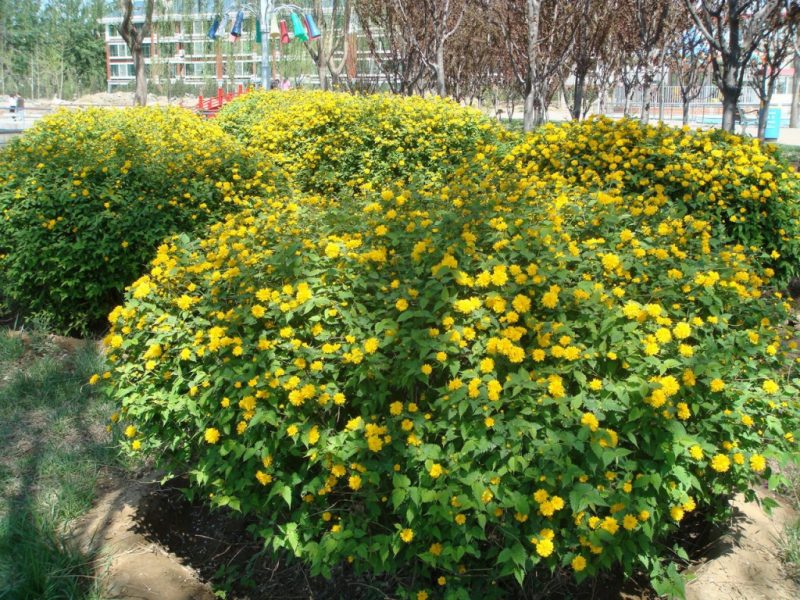
Due to the possibility of double flowering, the Kerry plant is often used by gardeners and landscape designers:
- when creating green fences;
- for registration of mixed rabatok;
- as a decoration of a front garden or flower garden;
- in the formation of mixed compositions, which are a picturesque background .;
- when creating decorative ensembles on green lawns.
Thus, Japanese Kerry, characterized by abundant and double flowering, will become an exquisite addition to the garden composition of both flowers and shrubs.


